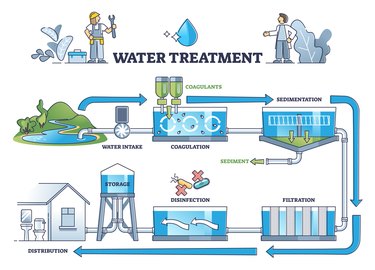Factories rely on water treatment polymer to improve treatment efficiency.
Factories rely on water treatment polymer to improve treatment efficiency.
Blog Article
Discover Exactly How Water Therapy Polymer Features in Efficient Wastewater Treatment Systems
The combination of water therapy polymers into wastewater treatment systems stands for a substantial development in enhancing operational performance. These polymers work primarily with devices of coagulation and flocculation, properly accumulating put on hold fragments for much easier elimination. Their convenience throughout varying ecological conditions adds to boosted sedimentation and reduced sludge quantity. Comprehending the specific types of polymers and their applications can disclose deeper understandings into maximizing therapy processes. What implications do these advancements hold for future wastewater management methods?
Introduction of Water Therapy Polymers
The effectiveness of wastewater management rests on the application of different therapy representatives, among which water therapy polymers play a crucial function. These synthetic or natural polymers are developed to boost the efficiency of physical and chemical processes in wastewater therapy systems. Their primary function is to promote the aggregation of suspended particles, ultimately enhancing the overall quality of cured water.
Water therapy polymers can be categorized into a number of classifications, consisting of flocculants, coagulants, and dispersants. Coagulants counteract the fees of put on hold bits, allowing them to come with each other and work out extra successfully.
The application of these polymers not just enhances the elimination of impurities however additionally optimizes the functional effectiveness of therapy plants. Additionally, the selection of proper water treatment polymers is essential, as their effectiveness can differ based upon aspects such as water chemistry, temperature level, and turbidity degrees. Overall, water treatment polymers are important elements in modern-day wastewater monitoring methods, adding to cleaner water and sustainable environmental techniques.
Devices of Coagulation and Flocculation
Coagulation and flocculation are essential processes in wastewater treatment that personify the concepts of fragment interaction and gathering. These devices are essential for eliminating suspended solids, colloids, and various other impurities from water. Coagulation involves the destabilization of suspended fragments, normally accomplished via the enhancement of coagulants such as steel salts. These coagulants reduce the effects of the electrostatic costs that maintain bits apart, advertising preliminary aggregation.
Following coagulation, flocculation happens, identified by the mild blending of water to motivate the formation of bigger accumulations, or flocs. During this stage, polymers play a considerable duty by linking in between bits, enhancing the development of these larger accumulations. The physical and chemical interactions throughout flocculation result in an increased dimension and thickness of the particles, facilitating their subsequent elimination via sedimentation or filtering.
The performance of coagulation and flocculation procedures is influenced by different aspects, consisting of pH, temperature, and the nature of the impurities existing. Comprehending these systems permits the optimization of wastewater treatment systems, resulting in improved removal performances and total water top quality. Consequently, the cautious option and check out this site application of coagulants and flocculants are crucial for successful wastewater monitoring.
Sorts Of Water Therapy Polymers
Regularly made use of in wastewater treatment, water therapy polymers are necessary for boosting the performance of coagulation and flocculation procedures. These polymers can be extensively categorized into 3 primary types: anionic, cationic, and non-ionic.
Anionic polymers, which bring an adverse cost, are particularly effective in dealing with wastewater with favorably charged pollutants. They facilitate the aggregation of suspended bits, advertising the formation of larger flocs that clear up quicker. Alternatively, cationic polymers have a favorable fee and are commonly utilized in applications where negatively charged bits dominate, such as in certain industrial effluents. Their ability to counteract fees allows the reliable binding of particles, causing enhanced sedimentation rates.
Non-ionic polymers, lacking a cost, work as flexible representatives that can boost the efficiency of both anionic and cationic polymers. Their primary duty involves increasing the viscosity of the wastewater, consequently improving the overall retention time of the flocs in the treatment system.
Comprehending the distinctive features of these kinds of water therapy polymers permits the optimization of wastewater page treatment processes, ultimately resulting in boosted removal effectiveness and improved water quality.
Applications in Wastewater Treatment

In local wastewater treatment plants, water therapy polymers assist decrease the quantity of sludge produced during the treatment procedure. water treatment polymer. This decrease not only maximizes functional performance but also decreases disposal expenses connected with sludge administration. Furthermore, polymers are critical in dealing with commercial effluents, where they assist in the elimination of certain pollutants such as hefty steels and natural pollutants, making certain compliance with environmental guidelines

Furthermore, water treatment polymers are utilized in the enhancement of biofiltration systems, where they enhance microbial task and general treatment effectiveness. Their function in membrane processes, such as reverse osmosis, additionally can not be ignored, as they add to membrane fouling control and prolong the life-span of purification systems. Via these diverse applications, water treatment polymers are crucial for achieving reliable and lasting wastewater monitoring.

Advantages of Using Polymers
Making use of water therapy polymers in wastewater systems provides countless advantages that considerably improve therapy efficiency and overall functional performance. These polymers act as reliable coagulants and flocculants, advertising the aggregation of suspended solids and facilitating their elimination. This procedure causes more clear effluent and minimizes the concern on downstream therapy stages.
Furthermore, polymers enhance the dewatering procedure by boosting the sedimentation attributes of sludge. This leads to lowered quantity and weight of waste material, ultimately lowering disposal expenses. Their capability to function throughout varying pH degrees and temperature levels makes sure flexibility in different wastewater environments.
Polymers additionally add to the stabilization of biological procedures by giving nutrients and keeping ideal conditions for microbial development - water treatment polymer. This boosted microbial here are the findings task help in the failure of organic issue, boosting general treatment effectiveness
In addition, making use of polymers can bring about minimized chemical use, decreasing operational costs and environmental impact. By maximizing the treatment procedure and enhancing sludge monitoring, water treatment polymers play an important duty in promoting sustainable wastewater management techniques, lining up with regulative standards and ecological objectives.
Conclusion
In verdict, water treatment polymers are essential for boosting the effectiveness of wastewater therapy systems. Their capacity to assist in coagulation and flocculation processes leads to enhanced sedimentation and lowered sludge volume, thereby enhancing therapy efficiency.
Report this page